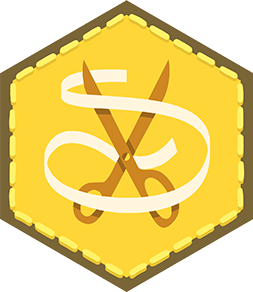Sew a yeti plushie
Sew a small yeti plushie using felt, stuffing, and simple hand stitches; follow a paper pattern, practice sewing skills, and add friendly details.



Step-by-step guide to sew a yeti plushie
Step 1
Gather all the materials from the list and put them on a clear table.
Step 2
Make or print a simple paper pattern of a small yeti body and any extra parts like arms and belly.
Step 3
Cut out your paper pattern pieces with scissors.
Step 4
Lay a paper pattern piece on the felt and trace around it with your marker.
Step 5
Cut the felt shapes out along the lines you traced.
Step 6
Thread the sewing needle and tie a small knot in the end of the thread.
Step 7
Practice a whip stitch three times on the scrap felt to feel how the stitch works.
Step 8
Put two matching body felt pieces together with the nice sides facing each other.
Step 9
Sew the body pieces around the edge with a whip stitch leaving a small gap for turning and stuffing.
Step 10
Turn the sewn body right side out through the gap so the nice side shows.
Step 11
Stuff the yeti gently through the gap until it looks plump and even.
Step 12
Sew the gap closed with small stitches and tie a secure knot when finished.
Step 13
Attach friendly details like eyes mouth and a belly patch by sewing them on with embroidery floss.
Step 14
Trim any loose threads and fluff the felt fur with your fingers to make your yeti extra cuddly.
Step 15
Share your finished yeti plushie on DIY.org
Final steps
You're almost there! Complete all the steps, bring your creation to life, post it, and conquer the challenge!


Help!?
What can I use if I can't find felt or embroidery floss for this yeti project?
Substitute fleece or an old soft cotton T‑shirt for the felt when tracing and cutting pattern pieces, and use thin yarn or stranded craft thread in place of embroidery floss for sewing on the eyes, mouth, and belly patch.
My whip stitches keep coming loose or the body is hard to turn inside out—how can I fix that?
Use the practice whip stitch step on scrap felt (step 6) to get consistent stitches, leave a slightly larger turning gap when sewing the body in step 7, and use a blunt tool like a chopstick to push stuffing evenly before closing the gap and tying a secure knot in step 11.
How should I change the steps for different ages working on this yeti plushie?
For preschoolers have an adult pre-cut felt pieces and let them stuff and glue or use a large plastic needle for simple sewing, for elementary kids supervise cutting and teach the whip stitch in step 6, and for older kids encourage designing extra pattern parts and detailed embroidery in step 12.
What are some ways to extend or personalize the yeti after finishing the basic plushie?
Before closing the gap in step 11 sew in a small bell or weighted beads for a tactile surprise, add yarn tufting or extra embroidery on the belly patch in step 12, and personalize it with stitched initials or a tiny felt accessory to share on DIY.org.
Watch videos on how to sew a yeti plushie
How to Sew a Yeti Water Bottle Holder | Easy Step-by-Step Sewing Tutorial for Beginners
Facts about hand sewing and plush toy making
🐑 Felt is one of the oldest textiles—people have been matting animal fibers into felt for thousands of years.
🧺 Modern plushies most often use polyester fiberfill (polyfill), which is lightweight, washable, and helps toys keep their shape.
🧵 Sewing is ancient: the oldest eyed sewing needle is around 40,000 years old, used to stitch warm clothing and gear.
🧸 The teddy bear was named after U.S. President Theodore Roosevelt in 1902 and helped popularize plush stuffed toys worldwide.
🐾 Yeti legends come from Himalayan folklore—one famous footprint once thought to be a Yeti was later linked to a reindeer.
How do I sew a small yeti plushie?
What materials do I need to sew a yeti plushie?
What ages is this activity suitable for?
How can I keep sewing a yeti plushie safe for kids?


One subscription, many ways to play and learn.
Only $6.99 after trial. No credit card required


